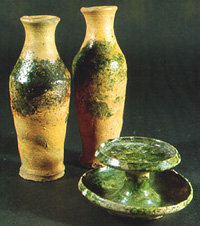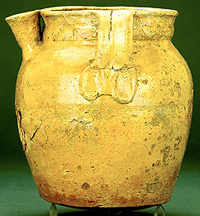| The ABC of pottery in archaeology |
| How was it made? | |
| Every vessel is capable of communicating details of its manufacture, whether hand-built or wheel-thrown, and the technology of its decoration, its glazing and how it was fired. It can also inform us about contemporary craftsmen (and women), and about the economic conditions of their communities. Larger studies can show how production was organised in the countryside and, more rarely, in the town. | 
Wheel-thrown biconical bottles and a saucer lamp decorated with mottled green glaze |

A wheel-thrown Stamford type spouted pitcher, made from fine estuarine clays in south Lincolnshire and excavated in Oxford. Its ownership may have carried a powerful social signal in the eleventh century (Courtesy of the Trustees of the British Museum) |
By comparing the find-spot with place of origin, we can map patterns of distribution, demonstrating marketing and exchange systems which can be compared with models deduced by historians and geographers for other commodities which survive less well. |
| Where does it come from? | The ABC of ... | How was it used, and by whom? |
| ©
Copyright University of Oxford, Ashmolean Museum, 2000 The Ashmolean Museum retains the copyright of all materials used here and in its Museum Web pages. last updated: jcm/27-jun-2000 |